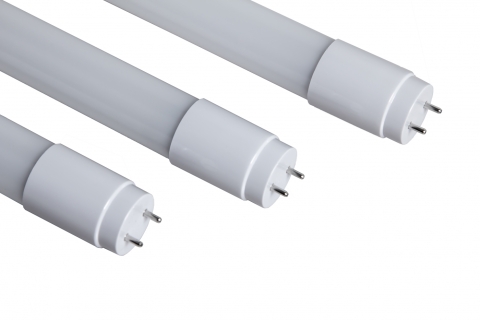
Convert your existing linear fluorescent fixture to LED lighting without needing a comprehensive reinstall. LED lamps are ideal for those seeking high energy savings with minimal installation time. These are the three (3) LED Lamp Types:
TYPE A LED LAMP - EASIEST INSTALLATION: LED Lamp with Integrated Driver – Works with Existing or New Linear Fluorescent Lamp Ballast
Type A Lamps are designed with an internal driver that allows them to work with linear fluorescent ballasts. Compatibility between tubes and ballasts should be evaluated to ensure good system performance.
Advantages: UL Type A LED Lamps offer the simplest installation process — retrofitting involves a simple swap of the existing Linear Fluorescent Fixture (LFL) with a Type A LED Lamp. Unlike the other options, no electrical or structural modification of the existing LFL fixture is required.
Disadvantages: However, with these benefits come some limitations. The longevity of a Type A system is dependent not only on the LED Lamp, but on the linear fluorescent ballast, which could result in additional maintenance costs within the lifetime of the solution. Ballast compatibility will vary by manufacturer and must be checked prior to install.
In addition, a Type A LED Lamp solution sacrifices efficiency due to the power consumption of the ballast and is limited in dimming and controllability options.
TYPE B LED LAMP — SIMPLEST TOTAL SYSTEM: Double-Ended Ballast Bypass LED Tubes - Wired to Main Incoming Power Supply
Type B LED Lamps also have an internal driver. Rather than operating off a ballast, however, Type B LED Lamps are powered directly from the main voltage supplied to the existing LFL fixture, requiring several important and unique considerations. It is strongly recommended to use “in-line fuse” with the Type B LED Lamp for additional protection.
Advantages: A Type B LED Lamp offers the simplest total system with respect to number of components — retrofitting involves wiring directly to main voltage, bypassing the ballast. This removes any compatibility issues and eliminates maintenance costs associated with ballast replacements.
Disadvantages: Installation of a Type B LED Lamped system requires electrical modification of the existing light fixture to connect the lamps to the power supply. This is more complicated than simply replacing lamps. Great care must be taken to follow installation instructions because wiring may vary across different manufacturers’ Type B LED Lamps.
Type B LED Lamps are more efficient than Type A LED Lamps, because there are no ballast-driven power losses. However, most Type B LED Lamps lack dimming and control capabilities. Note the light fixture’s incoming power wires are connected directly to the sockets. As a result, installers may potentially be exposed to main voltage during installation. For this reason, the LED Lamp includes an internal safety switch designed to prevent current from flowing through the lamp until both ends of the LED Lamp are energized with the sockets.
TYPE C LED LAMPS — BEST PERFORMANCE: LED Tubes with Remote Driver
Description: Type C LED Lamps operate off of a remote LED driver, instead of an integrated driver. Like the Type B LED Lamp, Type C LED Lamps require electrical modification to the existing light fixture, but the low-voltage outputs of the driver are connected to the sockets instead of the main voltage.
Advantages: Installation for Type C LED Lamps involve removing existing lamps and ballasts. The light fixture input wires must be connected to the LED driver, and the driver’s low-voltage output wires must then be connected to the sockets before installing the new LED Lamp. One driver can power multiple LED Lamps.
The Type C LED Lamp solution offers excellent system efficacy, ensures system compatibility, and greater overall performance. It can be integrated with dimming and control functionality to help offset moderate labor and installation costs with heightened efficiency into the future.
In Summary, to determine the best solution, you must consider the initial installation cost, long term maintenance implications, intended application, and overall which benefits are most desired:
- The Type A LED Lamp without ballast replacement offers an easy plug and play solution with the lowest initial cost.
- The Type B LED Lamp is the simplest total system, eliminating compatibility issues, but also has the highest installation cost.
- The Type C LED Lamp has a higher upfront cost but is the best “future-proofing” solution because it offers the ability to work with controls that are currently in place or would be installed at a later time.
All of EPCO's T8 LED Lamp RetroFit Conversion Kits accommodate these lamp types.